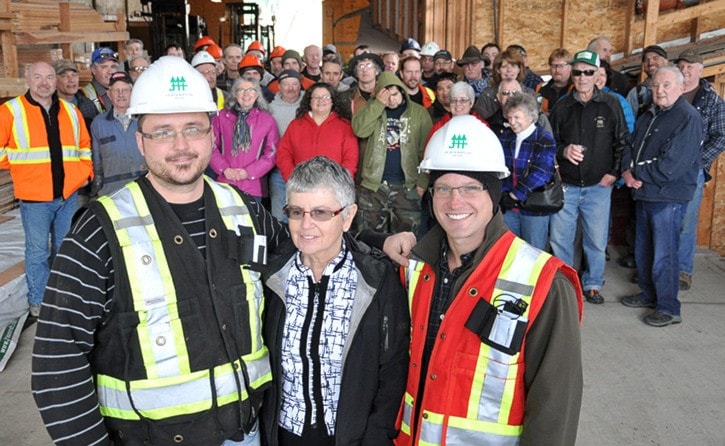From bookkeeping to lumber sales to management, Gwen Telling has been a fixture at Erickson’s J.H. Huscroft Ltd. sawmill since 1977. But that changed last week when she retired, leaving the day-to-day operations of the mill behind on Friday.
“It feels natural,” she said two days earlier, just after a surprise retirement party with the mill’s staff. “It’s just like when you leave home or get married or go to a different place. It’s the right thing to do. ...
“I’m a happy girl. I’ve got wings.”
Those wings will take Telling on her 13th trip to Honduras — she’s been before on Rotary projects — this time to teach English and study Spanish.
“It’s what I wanted to do at 19 and couldn’t,” she said. “It’s a second childhood.”
Telling’s grandfather, John Henry Huscroft, started the mill on his farm in 1927 — it moved to its 32 Avenue South location in 1960 — cutting timber and selling ties to the Great Northern Railroad in Idaho. Telling will remain on the board as corporate secretary, maintaining a family presence in the mill, but plans were already underway for others to succeed her.
In 2013, Justin Storm, who has now worked there for 16 years, signed a purchase agreement with the family-owned sawmill, becoming president and general manager.
“It was universally supported by all the shareholders,” Telling said. “Justin was the sawmill manager and just a really bright guy. We felt he would carry on our goals. One of our top goals was the older people — that employees who stuck with us through the hard times would still have jobs.”
Last month, Chris Schofer, who previously did sales for Wynnwood (then Wynndel Box and Lumber) and Colville, Wash.-based Vaagen Brothers Lumber, took over Telling’s position as lumber sales manager.
With her family — particularly her father, Ken, who died two years ago at age 88, and uncles Leonard and Mickey — operating the sawmill, Telling got a head start in the industry, which served her well while she was in Vancouver studying to be a certified general accountant. After working in the University of BC library for three years, she got a job at a sawmill office.
“I learned to tally lumber at 14,” she said. “I got the job because I knew how to tally lumber.”
In 1977, Telling came back to the Creston Valley to do the company’s books, and gradually worked her way into sales and management. At the time, business couldn’t have been better — but that didn’t last.
“It was sizzling,” she said. “Business was absolutely great. Then we came to 1980, and interest rates went up to eighteen per cent. That was when I realized the business would have some challenges.”
The 1980 recession was “extremely bad, but it was short-lived.” It didn’t compare, though, to the 2008 recession, which hit the industry after a few years of soft markets.
“We had a lot of really bad years,” Telling said. “The whole thing was really hard on everyone.”
Over the years, the mill has helped to strengthen its position as a company by not shying away from technological advances. Over Telling’s time at J.H. Huscroft, many operations have become automated, allowing for 40 per cent more lumber to be used instead of wasted.
“That’s been achieved by better technology,” she said.
With that technology came workers with more skills.
“As more manual jobs are being replaced, there are more millwrights and computer operators,” she said. “That trend will continue.”
Over time, reforestation practices have also changed, with mills taking the lead in replenishing their timber supply. J.H. Huscroft’s licence allows the cutting of 75,000 square metres a year on the company’s blocks, which the mill must then reforest.
“When I started, it was the government’s responsibility to reforest,” Telling said. “They were not meeting their obligations.”
That led to an outcry, and to the government requiring forestry companies to take care of reforestation — and they do the job right. Places Telling remembers seeing logged when she started in the business are now 40 or 50 feet high.
“The logging practices are better, reforestation is better and I think as people are recognizing that there is less hostility toward logging,” she said. “There are actually more trees in the forest because of logging, not less.”
That put an end to “vicious personal attacks” over the state of local forests.
“People see the new forests doing well,” Telling said. “That is a good thing for the timber supply and should be good for the future of the forest industry in Creston.”
And with the mill’s 90th anniversary on the horizon, Telling is proud of the legacy created by her family.
“My family has been logging in the valley for 100 years,” she said. “We’re still here and there is still a good resource here. I think it will be for years to come.”
This is the first article in a series on Erickson’s J.H. Huscroft Ltd. sawmill. Next: Looking to the future with president Justin Storm and lumber sales manager Chris Schofer.
